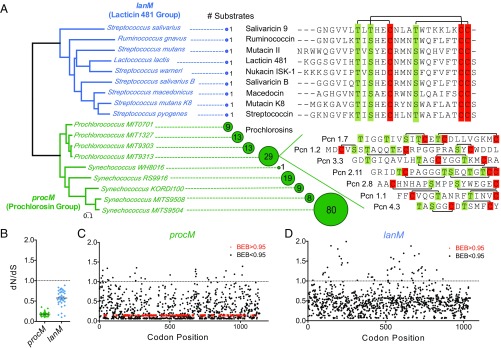Fig. 6.
Evolutionary history of two lineages of type II lanthionine synthetases. (A) Maximum-likelihood phylogeny of the procM genes of marine picocyanobacteria (green) and lanM genes of the lacticin 481 group found in Firmicutes (blue). The diameter of each circle is proportional to the number of cognate prochlorosin substrates (ProcA) of each ProcM enzyme. Sequence alignments of core peptide regions of members of the lacticin 481 group show the conservation of ring topology (black lines above sequence) among variants. Ring topologies for the 7 (of 29) prochlorosins from Prochlorococcus MIT9313 that have been determined are presented as an example of the extensive structural diversity in this group (6, 40). (B) Average value of the ratio between dS and dN substitution rates for every pairwise intraclade comparison for the entire length of the procM and lanM genes. (C and D) Codon-by-codon analysis of the synonymous and nonsynonymous substitution rates along lanthionine synthetase genes of the prochlorosin group (procM: C) and the lacticin 481 group (lanM: D). Significant dN/dS values are shown in red (BEB values greater than 0.95) indicating codons under purifying selection.

